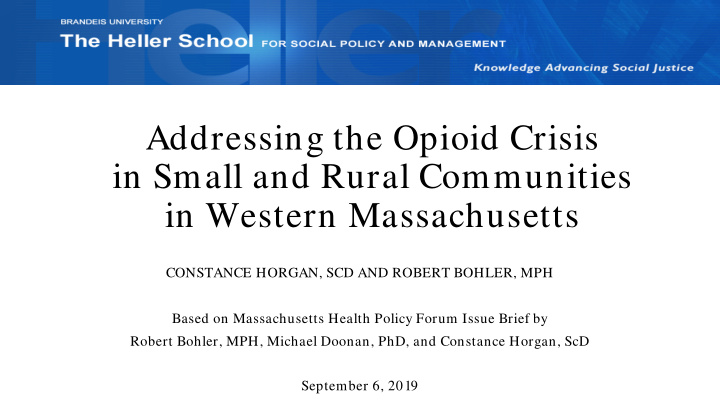



Addressing the Opioid Crisis in Small and Rural Communities in Western Massachusetts CONSTANCE HORGAN, SCD AND ROBERT BOHLER, MPH Based on Massachusetts Health Policy Forum Issue Brief by Robert Bohler, MPH, Michael Doonan, PhD, and Constance Horgan, ScD September 6, 2019
#addressingtheopioidcrisis #WesternMA We Join in Thanking the Funders of This Forum
OVERVIEW Extent of the Opioid Crisis in Western Massachusetts Unique Challenges in Western Massachusetts Best Practices and Innovative Programs Recommendations
Issue Brief: Approach and Themes Approach • Extensive literature search • Publicly available data and secondary data analysis • 24 semi-structured interviews with five key stakeholder groups: providers, community coalitions, criminal justice, government officials, and harm reduction specialists Themes • Importance of community collaboration • Rehabilitative role of the criminal justice system • Need to engage more people on medications for opioid use disorder (MOUD) • Expansion of harm reduction and recovery support services
The Problem : Epidem iology
MA Opioid Overdose Death Rate Significantly Higher than National Average 30 25 20 15 10 5 0 1999 2001 2003 2005 2007 2009 2011 2013 2015 2017 United States Massachusetts Source: Henry J. Kaiser Family Foundation (2019)
Opioid Overdoses are Increasing in Western Mass Source: Massachusetts DPH and U.S. Census *Per 100,000 People
Fentanyl is Increasing in Western MA Presence of Fentanyl in Opioid-Related Overdose Deaths 100 90 80 70 60 50 40 30 20 2015 2016 2017 2018 Western Mass Rest of State Projected Western Mass Projected Rest of State Source: Brandeis/IBH team. Data obtained through contract with Massachusetts DPH for 2015-2017 *2017 data is preliminary *2018 WMA data point is preliminary from Northwest DA Office; 2018 MA data point is preliminary state-level fentanyl percentage in opioid OD’s
County-level Prevalence of Opioid Use Disorder Franklin County Berkshire County Ham pshire County Ham pden County Source: Barocas et al. (2018)
Opioid Prescribing Higher in Western Mass % of Population Receiving Total Num ber of Dosage Schedule II Opioid Rx Units Per Capita Massachusetts 3.5 4.1 Franklin County 4.6 6.4 Berkshire County 4.5 5.1 Ham pshire County 3.8 5.5 Ham pden County 4.5 5.9 Source: Massachusetts DPH (2019) – 1 st Quarter of 2019
Who is at Greatest Risk? History of nonfatal Homelessness overdose Recently incarcerated Those prescribed Diagnosed opioids >3 mental illness months Mothers with opioid use disorder Low History of socioeconomic trauma* status* Source: Massachusetts DPH, Chapter 55 Report * - Denotes from Interviews
The Problem : Costs and Consequences
Economic Impact Cost of Opioid Crisis in MA: $15.2 billion (2017) $9.7 billion = Productivity losses $4.5 billion = Health care costs $50 0 m illion = Criminal justice costs $550 m illion = Public safety costs
Industry-Specific Impacts Source: Massachusetts DPH (2018)
Intergenerational and Community Impact Neonatal Abstinence Syndrome Foster Care System Grandparents Criminal Justice System
Unique Challenges in Western Massachusetts
Unique Challenges in Western Massachusetts Access to Treatment • Medications for Opioid Use Disorder (MOUD) • Transportation • Rural Isolation
Unique Challenges in Western Massachusetts Upstream Factors • Socioeconomic Distress • Trauma • Housing
Unique Challenges in Western Massachusetts General public Stigma Medical People in professionals recovery MOUD
Best Practices and Innovative Models in Western MA
BEST PRACTICES Com m unity Collaboration Prevention Early Intervention Treatm ent Recovery Support Services Harm Reduction
Community Collaboration Best Innovative Practices Models • Different types of • Hampshire HOPE coalitions • Opioid Task Force • Aligned leadership • Berkshire Opioid Abuse Prevention Collaborative • Hampden County Addiction Taskforce
Prevention Innovative Best Models Practices • Young Adult Empowerment • Use of Prescription Collaborative Drug Monitoring Program (PDMP) • Franklin Family Drug Court • Academic detailing • Education on safe storage and disposal • Prevention coalitions
Early Intervention Best Innovative Practices Models • Models targeting high- • Drug and Addiction risk populations Recovery Team (DART) • Integration of • Engaging Mothers for addiction services in Positive Outcomes with primary care Early Referrals (EMPOWER)
Treatment Best Innovative Practices Models • Franklin County Sheriff’s • Providing MOUD Office • Increasing touchpoints for • After Incarceration initiating MOUD Support Systems (AISS) • Access to entire treatment and recovery continuum of care
Recovery Innovative Best Models Practices • Recovery support centers (8 in Western Mass) • Recovery community organizations • Support for all pathways of recovery • Recovery support services
Harm Reduction Innovative Best Practices Models • Tapestry • Syringe service programs (SSPs) • Harm Reduction Hedgehogs • Naloxone distribution • Safety education
Recommendations
Recommendations 1. Increase and improve treatment workforce regarding trauma-informed care and physiology of addiction 2. Support and expand municipal-based coalitions and strengthen county-based coalitions 3. Continue interventions that lead to cautious opioid prescribing practices 4. Increase capacity of MOUD and increase MOUD initiation at vital touchpoints 5. Increase treatment role of the criminal justice system 6. Provide a robust and comprehensive treatment and recovery continuum of care that is supported by payors 7. Use low bandwidth technology as a cost-effective way to deliver services to underserved areas 8. Support the increased distribution of naloxone and other harm reduction strategies 9. Provide funding that is sustainable for the entire continuum of care 10. Address upstream factors related to OUD
Unique Challenges in Western Mass but also Unique Opportunity to Come Together Communities/ Leaders Health Care Systems and Other Organizations Task forces and Coalitions Academics
Thank you!
Recommend
More recommend